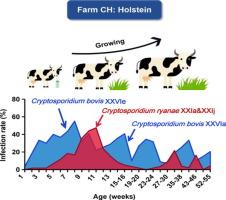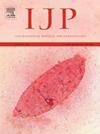Longitudinal follow-up reveals occurrence of successive Cryptosporidium bovis and Cryptosporidium ryanae infections by different subtype families in dairy cattle
Abstract
Cryptosporidium bovis and Cryptosporidium ryanae are common species causing cryptosporidiosis in cattle. Data accumulated thus far indicate that the infection patterns of the two species could be different between areas with and without Cryptosporidium parvum. To better understand the infection dynamics of these two species, cross-sectional and longitudinal studies of Cryptosporidium spp. were conducted using genotyping and subtyping tools. In the cross-sectional survey, analysis of 634 faecal samples from two farms identified only C. bovis and C. ryanae in pre-weaned calves. Two birth cohorts of 61 and 78 calves were followed longitudinally over a 12 month period, which revealed the shedding of C. bovis oocysts started at 1–2 weeks of age and peaked initially at 6–8 weeks of age. Altogether calves experienced four infections by six subtype families of C. bovis, with each infection caused by different subtype families. In contrast, the shedding of C. ryanae oocysts started at 2–4 weeks of age, and the two infections were caused by different subtype families. The cumulative incidence of C. bovis infection was 100% (58/58, 32/32) on both farms, compared with 84.4–98.3% (27/32 and 57/58) for C. ryanae infection. Overall, the mean duration of oocyst shedding in the cohort studies was 3.8–4.0 weeks for C. bovis compared with 2.1 weeks for C. ryanae. The oocyst shedding intensity was high (mean oocysts per gram of faeces was over 105) during the first infection with each species but became significantly lower in the later infections. Cryptosporidium ryanae was associated with the occurrence of diarrhea on one farm, while C. bovis was not. The data indicate that there is an early occurrence of C. bovis and C. ryanae in pre-weaned calves with high infection intensity in the absence of C. parvum. Calves infected with the same Cryptosporidium sp. multiple times could be associated with the presence of subtype-specific immunity.


 求助内容:
求助内容: 应助结果提醒方式:
应助结果提醒方式:


